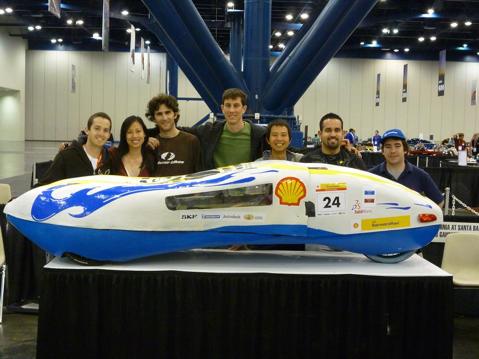UCSB Students-Designed Car Gets 735 Miles per Gallon
Mechanical Engineering Majors Place 16th in National Competition

When a team of eight UCSB mechanical engineering students pulled into Houston, Texas, last month, they brought along a car unlike any other seen on the roads of the South: a three-wheeled, 115-pound, high-mileage vehicle dubbed Gaucho IV.
They went there to race against teams from other schools in the United States and Canada. But this race was not about speed. Their competition, held on the streets of downtown Houston, aimed to determine which of the 38 teams in attendance had designed the most energy-efficient vehicle.
At 735 miles per gallon, the Gaucho IV students finished in 16th place, far behind the winning 2,488 miles-per-gallon efficiency of Laval University’s car.
Constructed out of fiberglass and carbon fiber, with an uncomfortable board for a seat, the Gaucho IV is unlikely to ever appear in a car dealership, said Veselin Kolev, a UCSB senior and one of the car’s designers. It was intended purely to see how efficient a gasoline-powered vehicle can be. “The goal was to create an aerodynamic car with low rolling resistance and a very efficient gas engine,” Kolev said.
Gaucho IV is the fourth iteration of what is known as the supermileage car, one of a number of projects senior mechanical engineers can undertake to satisfy their final requirements for the major. Using their budget of $5,250, which they raised last year using grants from UCSB departments and private donors, the team rebuilt the car’s gearbox and transmission, since those parts had failed in competition the previous year, Kolev said.
“Last year the team never got in a complete run of the track,” Kolev said. “The goal this year was to make sure it just works.” Behind the wheel for the team’s six time trials around the course was Sharice Handa, also a senior in the mechanical engineering department, who was chosen because she was the lightest member of the team and would add the least extra mass to the car. The first run got off to a rough start: unfamiliar with the vehicle’s handling, Handa flipped the car over going around a corner on the first lap, though both she and the car were unscathed. “We had installed a roll bar and a five-point safety harness and I was wearing a motorcycle helmet, so I wasn’t hurt at all,” Handa said.
Driving the supermileage car was not a matter of merely turning on the ignition and driving around. Rather than run the engine continuously for the entire trial, the UCSB team calculated the point at which the engine is most efficient, then revved the engine to that point before shutting it off to conserve fuel. “We averaged 20 to 25 miles per hour,” Kolev said. “But we’re one of the faster cars and it got kind of hairy because it was only a two-lane street, so we were trying to pass cars a lot.”
Another aspect of the car’s efficiency was its low weight, allowing it to conserve momentum. While the car’s chassis is made out of aluminum, Handa said the team saved a significant amount of weight by making a fiberglass frame and a carbon fiber and Kevlar baseboard for the car. The choice of lightweight bicycle wheels and a small scooter motor further reduced the car’s weight, Kolev said.
Though impractical for public roads, UCSB Senior Superintendent of Shops Andy Weinberg, who advised the students on the project, said the hope is for the students to extend the fuel-efficiency lessons of this project to the real world. “We’re basically getting students to think on saving energy for the future and go out thinking about better energy policies,” Weinberg said.
For next year, Kolev said he hopes his team’s successor focuses on improving the car’s fuel efficiency, which the team was not able to address this year. “The car runs in its current condition, so now we need to improve its engine efficiency,” Kolev said. “This is a never-ending project.”


